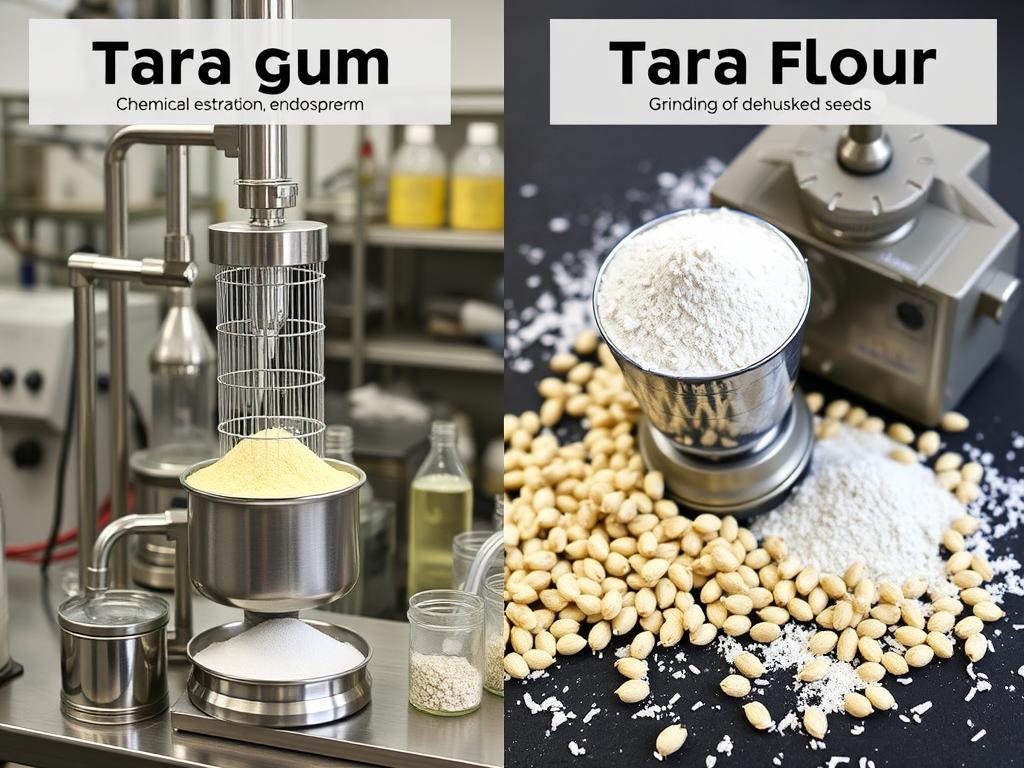
Tara Gum vs Tara Flour: Key Differences, Uses, and Benefits
SUBSCRIBE TO OUR BLOG
Promotions, new products, and recipes.
Understanding the distinction between tara gum vs tara flour has become increasingly important, especially following safety concerns that emerged in 2022. Both ingredients come from the same plant source but differ significantly in processing, applications, and safety profiles. This comprehensive guide explores everything you need to know about these two ingredients, helping you make informed choices for your cooking and dietary needs.
What Are Tara Gum and Tara Flour?
The tara tree (Caesalpinia spinosa) produces seeds used to make both tara gum and tara flour
Both tara gum and tara flour are derived from the seeds of the tara tree (Caesalpinia spinosa), which grows primarily in the Andean regions of South America. Despite sharing the same source, these two ingredients have distinct properties and uses in the food industry.
Tara Gum
Tara gum is a hydrocolloid extracted from the endosperm of tara seeds through chemical processing. It functions primarily as a thickening agent and stabilizer in various food products. With its high galactomannan polysaccharide content, tara gum has been safely used in the food industry for approximately 30 years.
Tara Flour
Tara flour is produced by grinding the dehusked seeds of the tara tree into a powder. Unlike tara gum, tara flour gained public attention in 2022 when it was identified as a potential cause of illness in hundreds of consumers who ate a specific frozen food product containing this ingredient.
Want to learn more about food additives?
Discover how different plant-based thickeners and stabilizers work in your food.
Explore FDA's Food Additive ListProcessing Methods: How They're Made

The key differences between tara gum vs tara flour begin with how they're processed. These distinct manufacturing methods result in products with very different properties and safety profiles.
| Processing Aspect | Tara Gum | Tara Flour |
| Source Part | Endosperm of tara seeds | Whole dehusked seeds |
| Extraction Method | Chemical processing to isolate galactomannans | Mechanical grinding into powder |
| Refinement Level | Highly refined | Minimally processed |
| Resulting Composition | Primarily galactomannan polysaccharides | Complex mixture of proteins, fibers, and other compounds |
The extensive processing that tara gum undergoes removes many compounds present in the whole seed, resulting in a more purified ingredient with well-established safety. In contrast, tara flour contains a broader spectrum of the seed's natural compounds, some of which may not have been thoroughly studied for food safety.
Properties and Characteristics Comparison

When comparing tara gum vs tara flour, their physical and functional properties reveal significant differences that impact their applications and safety profiles.
Tara Gum Properties
- Fine, uniform white to yellowish powder
- Highly water-soluble, forming viscous solutions
- Functions as a thickener and stabilizer
- Provides smooth, consistent texture
- Stable across a wide pH range
- Synergistic with other hydrocolloids
Tara Flour Properties
- Slightly coarser powder with variable color
- Less water-soluble than tara gum
- Higher protein content (used as protein source)
- More pronounced flavor profile
- Contains more of the seed's natural compounds
- More variable in composition between batches
Important Note: The FDA has determined that tara gum has a "well-established safety profile," while tara flour has been deemed "not Generally Recognized As Safe" following investigations into illness outbreaks potentially linked to its consumption.
Nutritional Profiles
The nutritional profiles of tara gum and tara flour differ significantly, reflecting their distinct processing methods and intended uses in food applications.
| Nutritional Component | Tara Gum | Tara Flour |
| Calories | Low (primarily fiber) | Higher (contains protein and carbohydrates) |
| Protein Content | Minimal | Significant (marketed as protein source) |
| Fiber Content | Very high (soluble fiber) | Moderate (mix of soluble and insoluble) |
| Digestibility | Largely passes through digestive system | More fully digested |
Applications and Uses

Tara Gum Applications
Tara gum has been widely used in the food industry for decades, primarily as a stabilizer and thickening agent. Its applications include:
- Ice cream and frozen desserts - prevents ice crystal formation
- Dairy products like yogurt and cheese - improves texture and mouthfeel
- Sauces and dressings - provides stability and consistent viscosity
- Baked goods - enhances moisture retention and shelf life
- Plant-based alternatives - mimics dairy textures in vegan products
- Pharmaceuticals - used in pill coatings and as a binding agent

Tara gum helps create smooth, creamy textures in frozen desserts
Tara Flour Applications
Tara flour had been emerging as an ingredient in certain food applications before safety concerns arose. Its potential uses included:
- Plant-based protein products - as a protein source
- Gluten-free baking - as an alternative flour
- Protein-enriched foods - to boost protein content
- Specialized dietary products - for specific nutritional profiles
Safety Warning: Following investigations into illnesses potentially linked to tara flour, the FDA has determined it is "not Generally Recognized As Safe" for food use. Products containing tara flour should be avoided until further safety assessments are completed.
Looking for safe food thickeners?
Discover alternative plant-based thickeners and stabilizers with established safety profiles.
Explore Safe AlternativesSafety Profiles and Regulatory Status
The safety profiles of tara gum and tara flour differ significantly, with important regulatory distinctions that consumers should understand.
Tara Gum Safety
Tara gum has a well-established safety record spanning approximately 30 years of use in food products. The FDA has specifically noted that tara gum's "safety profile is well established supporting its use as a thickening agent and/or stabilizer in human foods."
Key safety points include:
- Determined GRAS (Generally Recognized As Safe) by expert panels
- Low toxicity profile confirmed by multiple safety assessments
- Approved for use in the EU and by the Joint FAO/WHO Expert Committee
- Long history of safe use in various food applications
- Well-characterized chemical composition
Tara Flour Safety
In contrast, tara flour has been linked to safety concerns following a 2022 incident where hundreds of consumers reported illness after consuming a product containing tara flour.
Key safety concerns include:
- FDA determined tara flour is "not Generally Recognized As Safe"
- Linked to approximately 329 illnesses and 113 hospitalizations
- Some consumers required gallbladder removal after exposure
- Insufficient safety data available for general consumption
- No food additive regulation establishing safe use conditions
"Tara gum is distinct from tara flour, as it is predominantly composed of galactomannan polysaccharides, and its safety profile is well established supporting its use as a thickening agent and/or stabilizer in human foods."
How to Choose the Right Ingredient
When considering tara-derived ingredients, safety should be your primary concern. Based on current information and FDA guidance:
Tara Gum Recommendations
- Safe for use in food products as a thickener and stabilizer
- Ideal for improving texture in ice cream, yogurt, and sauces
- Effective in small quantities (typically 0.1-0.5% of formulation)
- Works well in combination with other hydrocolloids
- Suitable for vegetarian and vegan food applications
Tara Flour Cautions
- Currently not recognized as safe by the FDA
- Linked to serious adverse health effects in some consumers
- Should be avoided until further safety assessments are completed
- Check ingredient labels carefully to avoid products containing it
- Consider safer alternative protein sources and flours
Stay informed about food ingredient safety
Get updates on food safety alerts and ingredient information directly from the FDA.
Subscribe to FDA Safety AlertsSafe Alternatives to Consider
If you're looking for alternatives to tara-derived ingredients, several safe options are available:
Alternatives to Tara Gum
- Xanthan Gum - Versatile thickener with similar properties
- Guar Gum - Plant-based thickener from guar beans
- Locust Bean Gum - Similar galactomannan structure
- Agar Agar - Seaweed-derived gelling agent
- Pectin - Fruit-derived thickener for specific applications
Alternatives to Tara Flour
- Chickpea Flour - High protein, versatile alternative
- Pea Protein - Well-established plant protein source
- Hemp Flour - Nutritious alternative with protein
- Almond Flour - Low-carb alternative for baking
- Quinoa Flour - Complete protein profile

Delicious foods made with safe alternatives to tara-derived ingredients
Frequently Asked Questions
Is tara gum safe to consume?
Yes, tara gum has a well-established safety profile and has been used in food products for approximately 30 years. The FDA has specifically noted that tara gum's safety profile supports its use as a thickening agent and stabilizer in human foods.
Should I avoid products containing tara flour?
Yes, the FDA has determined that tara flour is "not Generally Recognized As Safe" following investigations into illnesses potentially linked to its consumption. Until further safety assessments are completed, it's advisable to avoid products containing tara flour.
How can I tell if a product contains tara gum vs tara flour?
Check the ingredient list carefully. Tara gum will be listed specifically as "tara gum" and is commonly found in ice cream, yogurt, and other products requiring stabilization. Tara flour would be listed as "tara flour" or potentially as "tara protein" and was primarily used in specialized protein products.
What symptoms were associated with tara flour consumption?
Reported symptoms included fever, fatigue, vomiting, diarrhea, and liver problems. Some consumers experienced such severe symptoms that they required gallbladder removal. If you experience these symptoms after consuming a product that might contain tara flour, seek medical attention.
Are there other names for tara gum I should look for on labels?
Tara gum is typically listed simply as "tara gum" on ingredient labels. It may occasionally be referred to as "Caesalpinia spinosa gum" or "Peruvian carob gum," though these names are less common in U.S. food labeling.
Conclusion: Making Informed Choices

Understanding the differences between tara gum vs tara flour is essential for making informed food choices. While both ingredients derive from the same plant source, they have vastly different safety profiles and applications.
Tara gum remains a safe, effective thickening agent and stabilizer with decades of established use in the food industry. Its unique properties make it valuable in various food applications, particularly in creating smooth textures in frozen desserts and dairy products.
In contrast, tara flour has been associated with serious health concerns and is currently not recognized as safe by the FDA. Until further research establishes its safety, consumers should avoid products containing this ingredient.
By staying informed about food ingredients and their safety profiles, you can make better choices for your health and well-being. Always check ingredient labels carefully and stay updated on food safety information from reliable sources.
Want to learn more about food ingredients?
Download our comprehensive guide to understanding food additives and making informed choices.
Get Your Free Guide

|
About the Author Ed is the founder of Cape Crystal Brands, editor of the Beginner’s Guide to Hydrocolloids, and a passionate advocate for making food science accessible to all. Discover premium ingredients, expert resources, and free formulation tools at capecrystalbrands.com/tools. — Ed |
Enjoyed this post? Subscribe to The Crystal Scoop
Food-science tips, ingredient know-how, and recipes. No spam—unsubscribe anytime.
- Choosing a selection results in a full page refresh.



